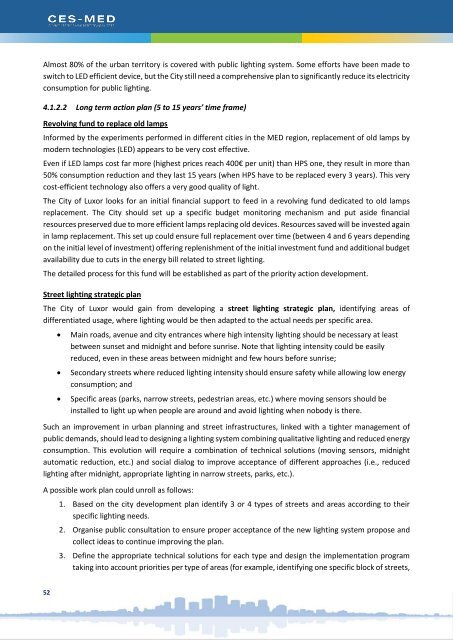280218_Luxor-Egypt SECAP Final_revised
Create successful ePaper yourself
Turn your PDF publications into a flip-book with our unique Google optimized e-Paper software.
Almost 80% of the urban territory is covered with public lighting system. Some efforts have been made to<br />
switch to LED efficient device, but the City still need a comprehensive plan to significantly reduce its electricity<br />
consumption for public lighting.<br />
4.1.2.2 Long term action plan (5 to 15 years’ time frame)<br />
Revolving fund to replace old lamps<br />
Informed by the experiments performed in different cities in the MED region, replacement of old lamps by<br />
modern technologies (LED) appears to be very cost effective.<br />
Even if LED lamps cost far more (highest prices reach 400€ per unit) than HPS one, they result in more than<br />
50% consumption reduction and they last 15 years (when HPS have to be replaced every 3 years). This very<br />
cost-efficient technology also offers a very good quality of light.<br />
The City of <strong>Luxor</strong> looks for an initial financial support to feed in a revolving fund dedicated to old lamps<br />
replacement. The City should set up a specific budget monitoring mechanism and put aside financial<br />
resources preserved due to more efficient lamps replacing old devices. Resources saved will be invested again<br />
in lamp replacement. This set up could ensure full replacement over time (between 4 and 6 years depending<br />
on the initial level of investment) offering replenishment of the initial investment fund and additional budget<br />
availability due to cuts in the energy bill related to street lighting.<br />
The detailed process for this fund will be established as part of the priority action development.<br />
Street lighting strategic plan<br />
The City of <strong>Luxor</strong> would gain from developing a street lighting strategic plan, identifying areas of<br />
differentiated usage, where lighting would be then adapted to the actual needs per specific area.<br />
• Main roads, avenue and city entrances where high intensity lighting should be necessary at least<br />
between sunset and midnight and before sunrise. Note that lighting intensity could be easily<br />
reduced, even in these areas between midnight and few hours before sunrise;<br />
• Secondary streets where reduced lighting intensity should ensure safety while allowing low energy<br />
consumption; and<br />
• Specific areas (parks, narrow streets, pedestrian areas, etc.) where moving sensors should be<br />
installed to light up when people are around and avoid lighting when nobody is there.<br />
Such an improvement in urban planning and street infrastructures, linked with a tighter management of<br />
public demands, should lead to designing a lighting system combining qualitative lighting and reduced energy<br />
consumption. This evolution will require a combination of technical solutions (moving sensors, midnight<br />
automatic reduction, etc.) and social dialog to improve acceptance of different approaches (i.e., reduced<br />
lighting after midnight, appropriate lighting in narrow streets, parks, etc.).<br />
A possible work plan could unroll as follows:<br />
1. Based on the city development plan identify 3 or 4 types of streets and areas according to their<br />
specific lighting needs.<br />
2. Organise public consultation to ensure proper acceptance of the new lighting system propose and<br />
collect ideas to continue improving the plan.<br />
3. Define the appropriate technical solutions for each type and design the implementation program<br />
taking into account priorities per type of areas (for example, identifying one specific block of streets,<br />
52

















